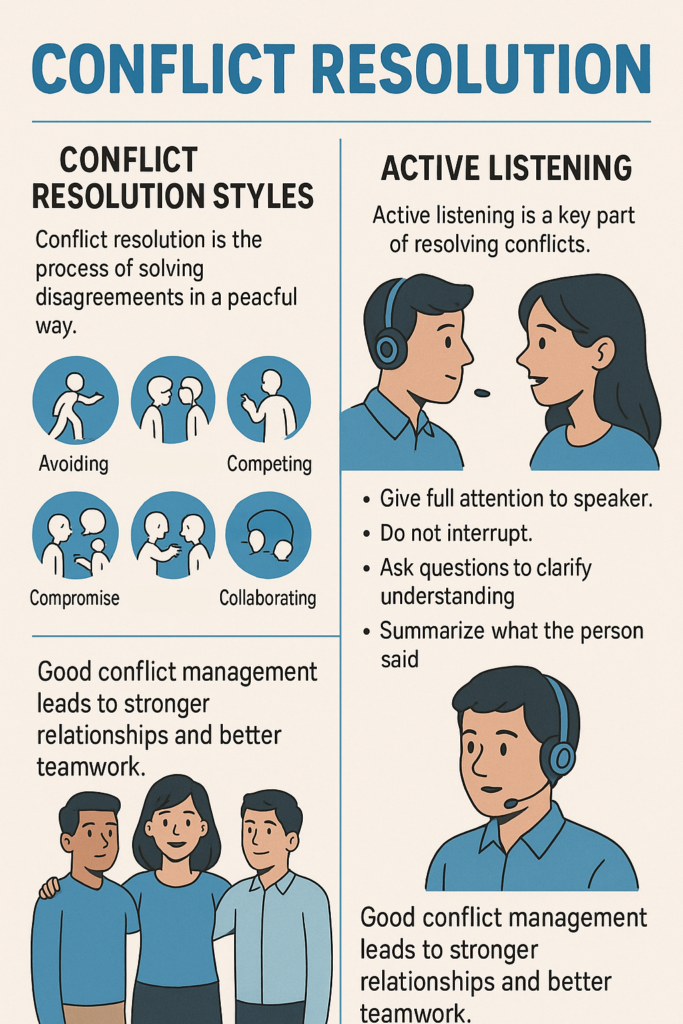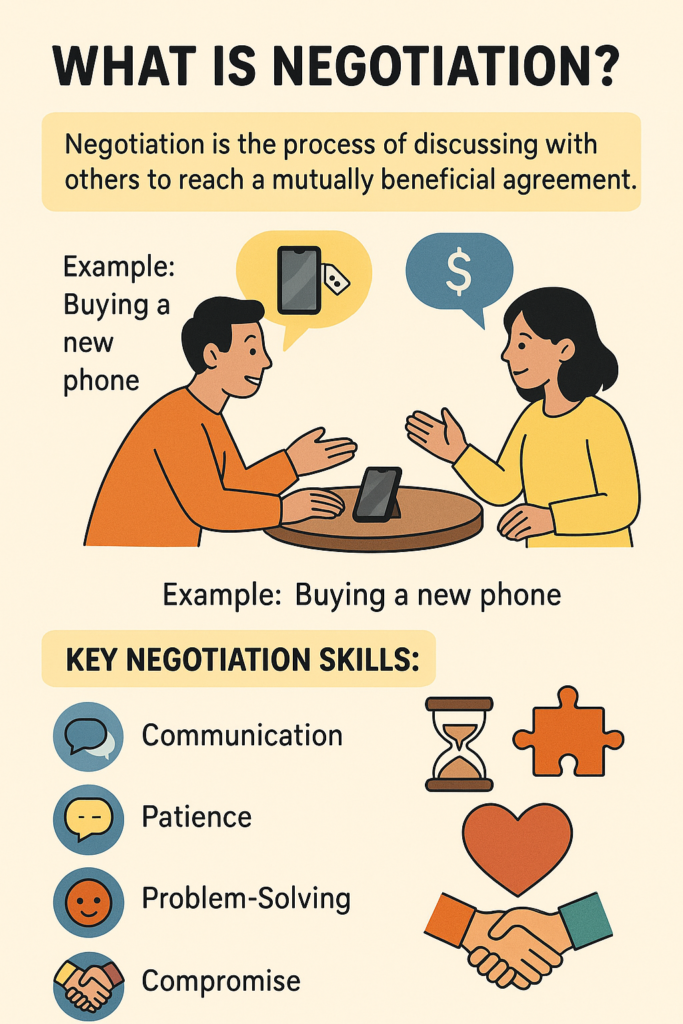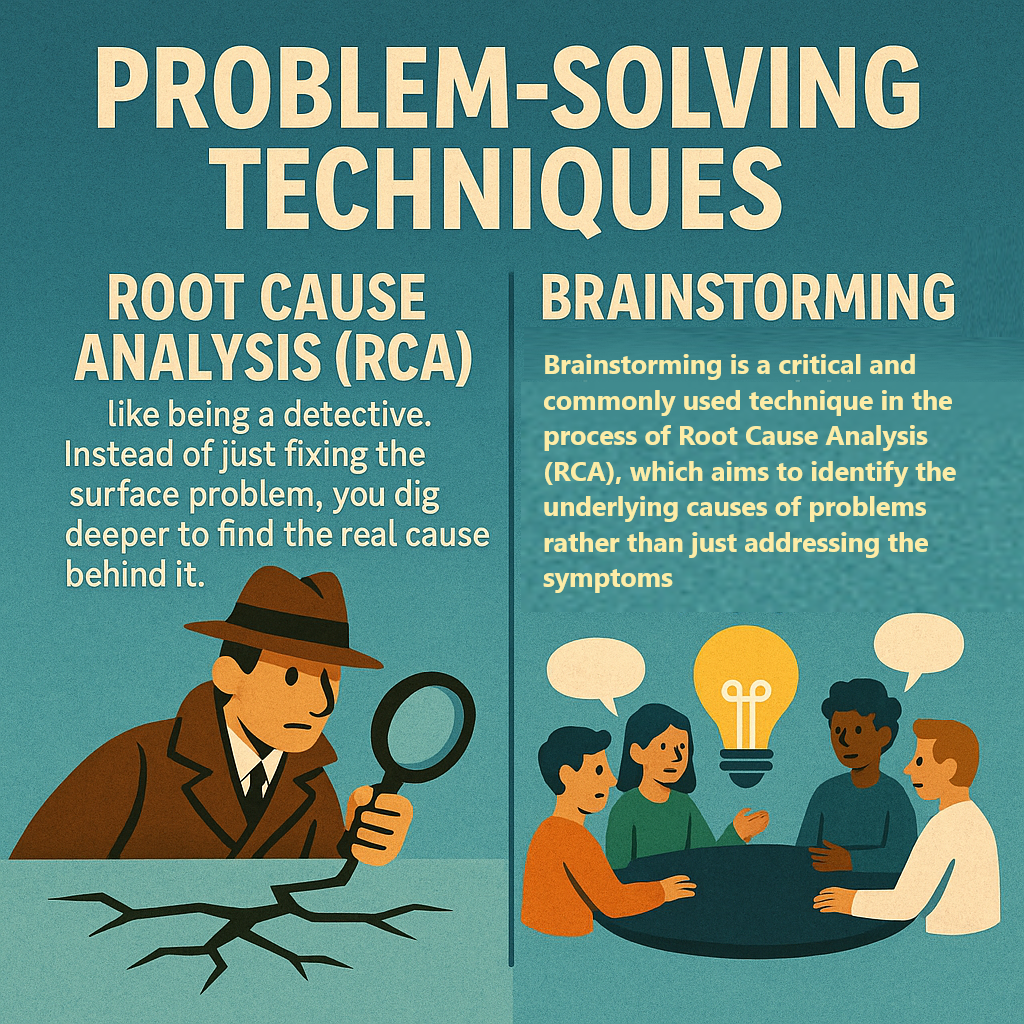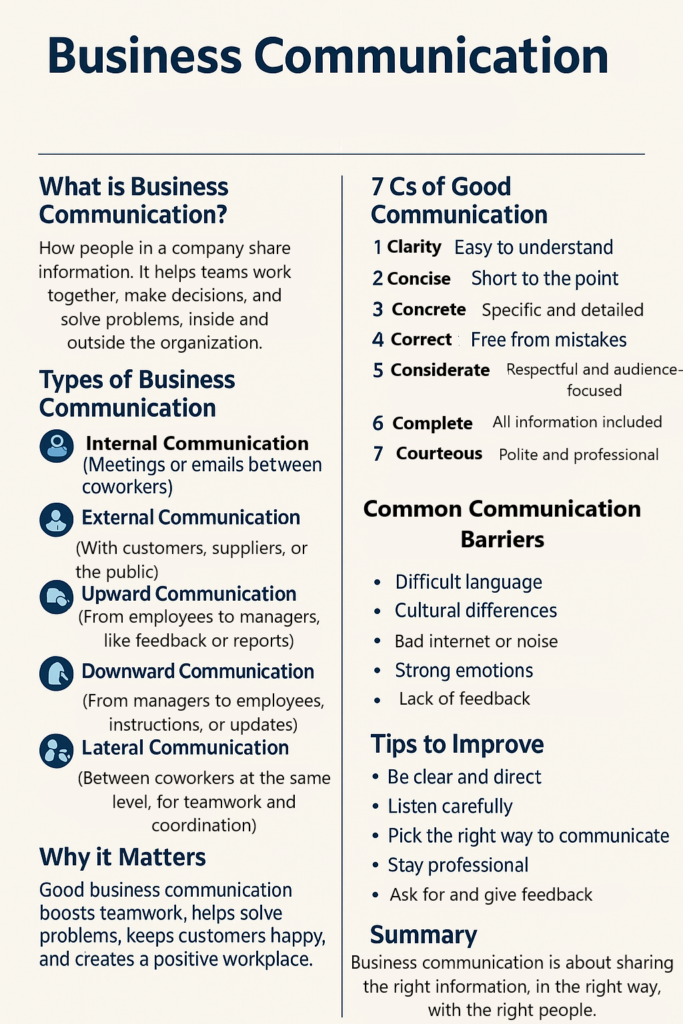What is Conflict Resolution?
Conflict resolution is the process of resolving a disagreement or conflict between two or more people, groups, or parties. It’s about finding a peaceful solution when people have different views, needs, or interests that are causing tension.
Imagine two friends who both want to play with the same toy. They have a conflict because they both want it at the same time. Conflict resolution helps them figure out a way to solve the problem without fighting or becoming upset.

In the workplace or in any situation, conflict resolution helps people work together by finding solutions that satisfy everyone, or at least reduce tension.
Why is Conflict Resolution Important?
- Prevents escalation: If conflicts are not resolved, they can grow into bigger problems.
- Improves relationships: Solving conflicts in a healthy way can actually make relationships stronger.
- Boosts productivity: When conflicts are resolved, people can focus on their tasks and work together more efficiently.
- Creates harmony: Resolving conflicts helps create a peaceful and collaborative environment.
Key Methods of Conflict Resolution
There are several approaches to resolving conflicts. These are the most common:
- Avoidance:
Sometimes, people choose to avoid the conflict altogether, hoping it will go away on its own. This can work in situations where the conflict is minor or doesn’t really matter in the long term.- Example: If two coworkers argue over a small task, one might just let it go to avoid more tension.
- Pros: Saves time and energy when the issue isn’t important.
- Cons: Might let the problem grow if it’s not addressed.
- Accommodating:
This method involves one person giving in to the other’s wishes, usually to maintain harmony or avoid further conflict. One person may decide to “let the other win” to keep the peace.- Example: In the toy situation, one friend might let the other have the toy first.
- Pros: Can help avoid arguments and maintain peace.
- Cons: The person who gives in might feel resentful or unheard.
- Competing:
This is when one party takes a strong stance and fights for their own way, sometimes at the expense of the other party. It can lead to a win-lose situation.- Example: One person insists on keeping the toy and refuses to let the other play with it.
- Pros: Might be necessary in urgent situations where a decision needs to be made quickly.
- Cons: It can create hostility and harm relationships.
- Compromising:
In this approach, both parties give up something to reach a solution that partially satisfies both. It’s a middle ground where both sides make concessions.- Example: The two friends agree to take turns playing with the toy.
- Pros: Both parties get some of what they want, and it can be a quick way to settle disagreements.
- Cons: Neither party may be fully satisfied, as they have to give up something.
- Collaborating:
This is the best approach in most cases. It involves both parties working together to find a win-win solution where both get what they want. It’s about understanding each other’s needs and working to meet them in a way that benefits both.- Example: The two friends might decide to share the toy by playing with it together.
- Pros: Everyone is satisfied, and it strengthens relationships.
- Cons: It can take more time and effort to find a solution.
What is Negotiation?
Negotiation is a discussion between two or more people or parties aimed at reaching an agreement. It’s like problem-solving through conversation. Negotiation happens when two parties have different interests, and they try to find a middle ground or agreement that works for both.
Imagine two people trying to buy a used car. One person wants to sell it for $5,000, but the buyer thinks it’s worth only $4,000. They negotiate to agree on a price that works for both of them.
Why is Negotiation Important?
- Creates win-win solutions: Good negotiation allows both parties to leave feeling satisfied.
- Helps build relationships: Negotiating with respect and fairness can improve relationships, whether personal or professional.
- Reduces misunderstandings: By talking openly and clearly, negotiation clears up misunderstandings and prevents future conflicts.
- Improves problem-solving skills: Negotiation helps people think critically and creatively to find solutions.
Steps in the Negotiation Process
Negotiation doesn’t happen randomly—it follows some key steps:
- Preparation:
Before you start negotiating, you need to know what you want and what you’re willing to give up. This is the time to gather information, understand your goals, and think about the other party’s needs and interests.- Example: If you’re negotiating a salary, you need to know your desired salary, but also research what’s reasonable based on your experience and the company’s budget.
- Opening:
In the opening phase, both parties share their goals and what they hope to achieve. This is a good time to state your position clearly, but also to listen to the other party.- Example: You tell the car seller that you want to buy the car for $4,000, and they explain why they think it’s worth $5,000.
- Exploration:
This is when both sides discuss their interests and concerns in more detail. It’s important to listen carefully and ask questions to understand the other party’s perspective.- Example: You might ask the car seller why they’re asking for $5,000 and whether they’re open to a lower price.
- Bargaining:
Here, both parties make offers, counteroffers, and concessions. This is where most of the negotiation happens, as each side works toward a deal.- Example: You offer $4,200, and the seller counters with $4,800. After some back-and-forth, you agree on $4,500.
- Closing:
In this step, both sides agree on the terms and confirm the deal. This is the moment when both parties shake hands (or sign a contract) to finalize the agreement.- Example: You and the seller agree to the price of $4,500 and agree on a time for you to pick up the car.
Conflict Resolution vs. Negotiation: Key Differences
- Conflict resolution focuses on solving disagreements and finding solutions to problems that arise between people. It could involve managing emotions and maintaining relationships.
- Negotiation is a specific type of communication focused on reaching a mutually acceptable agreement, usually over something concrete (e.g., price, terms, etc.).
While negotiation is one method of resolving conflicts, conflict resolution can include other methods like mediation or simply letting go of minor issues.
Summary:
- Conflict Resolution is about finding peaceful solutions to disagreements, and there are different strategies like avoiding, accommodating, competing, compromising, and collaborating.
- Negotiation is the process of discussing and coming to an agreement on a specific issue, where both parties try to reach a win-win solution.
Both skills are essential for handling differences and ensuring that everyone’s needs are respected, whether in personal relationships, at work, or in business settings. By mastering conflict resolution and negotiation, you can create better outcomes, stronger relationships, and a more peaceful environment.








